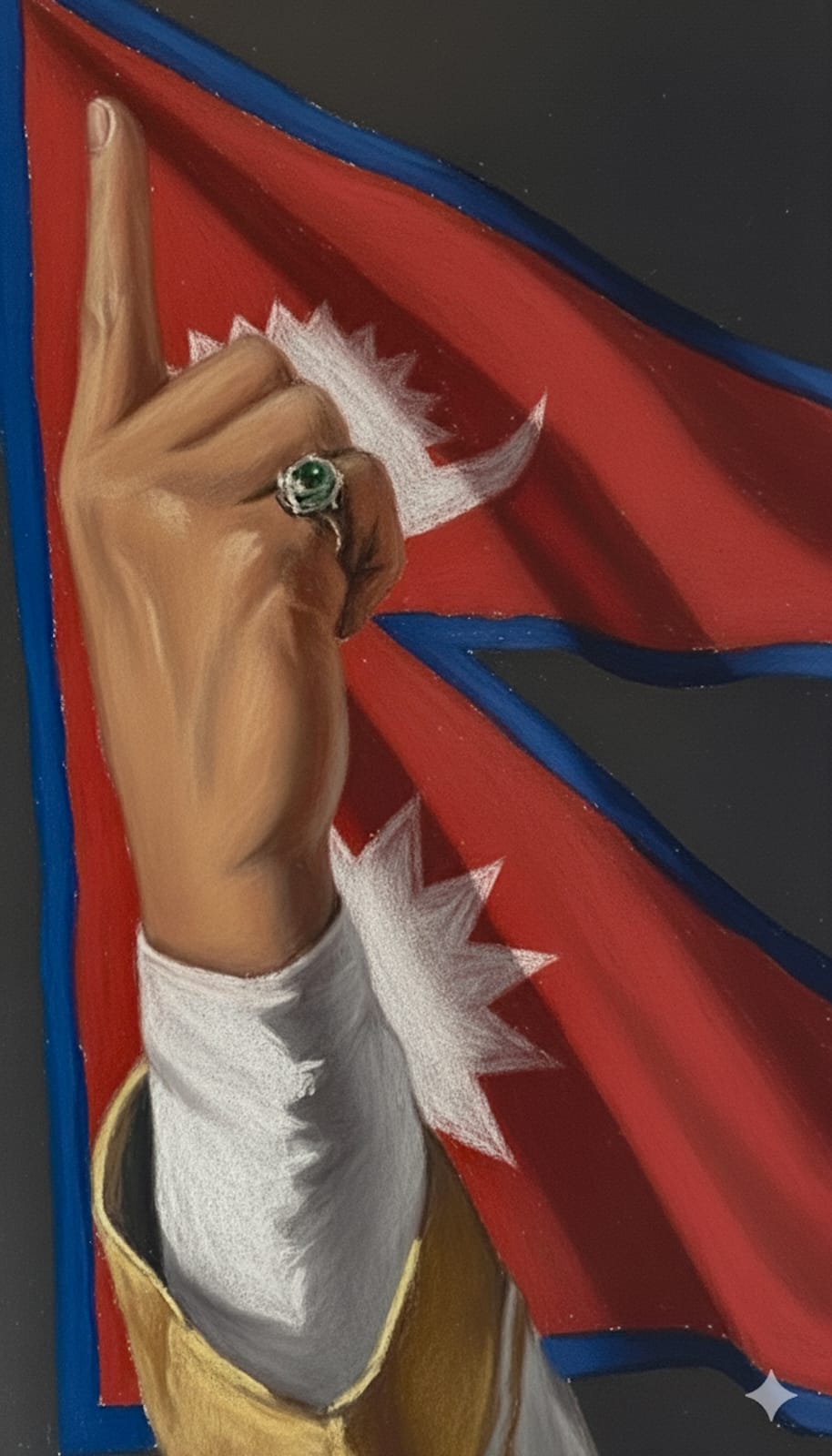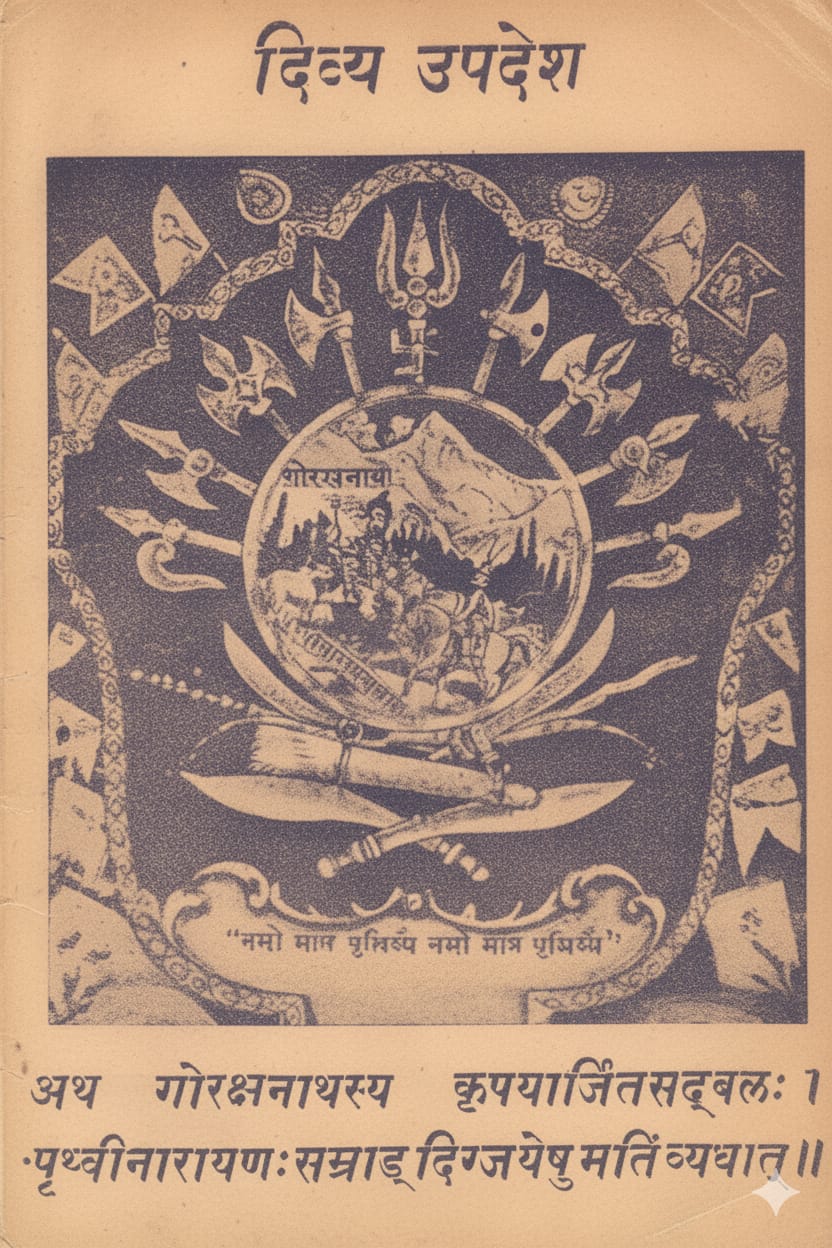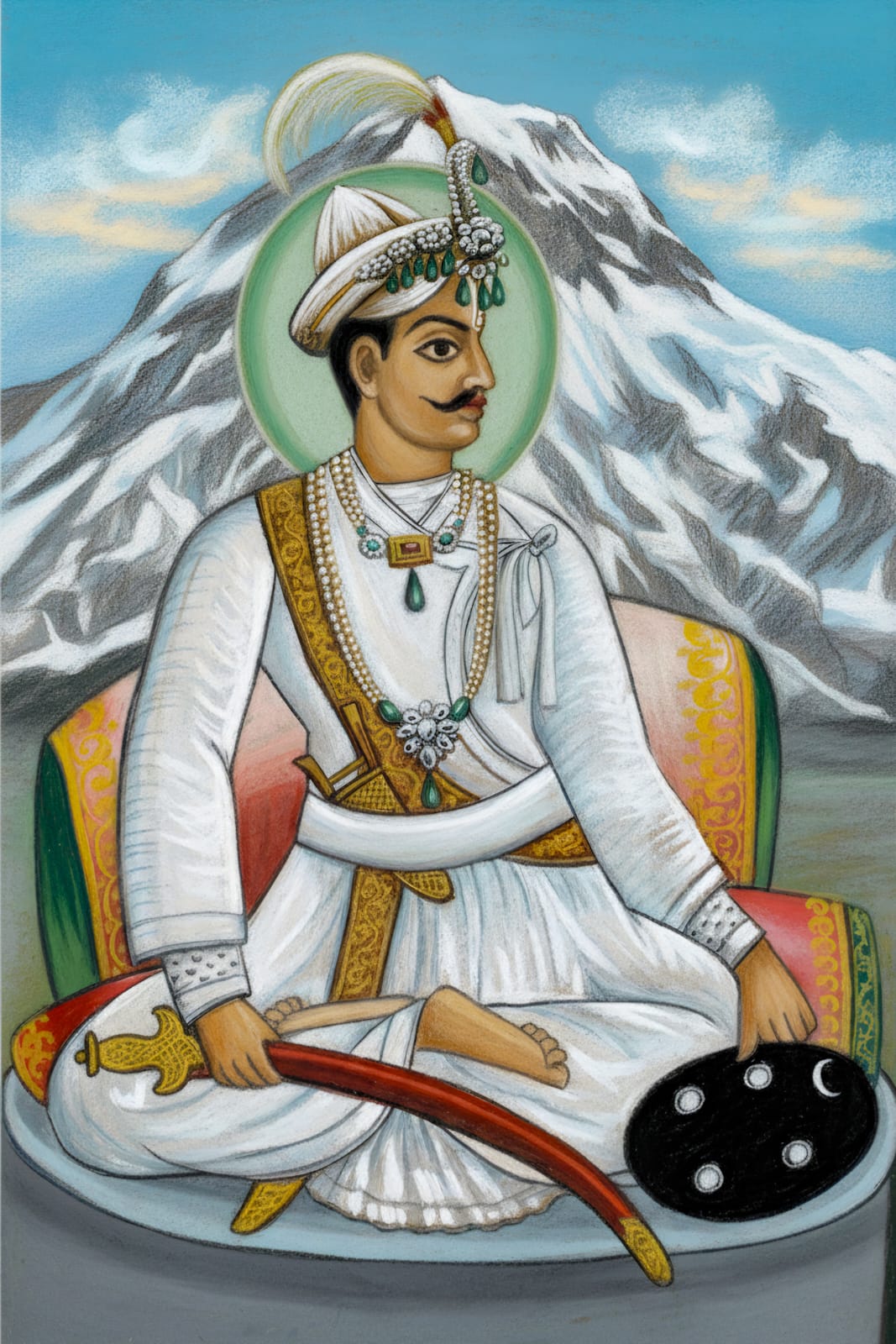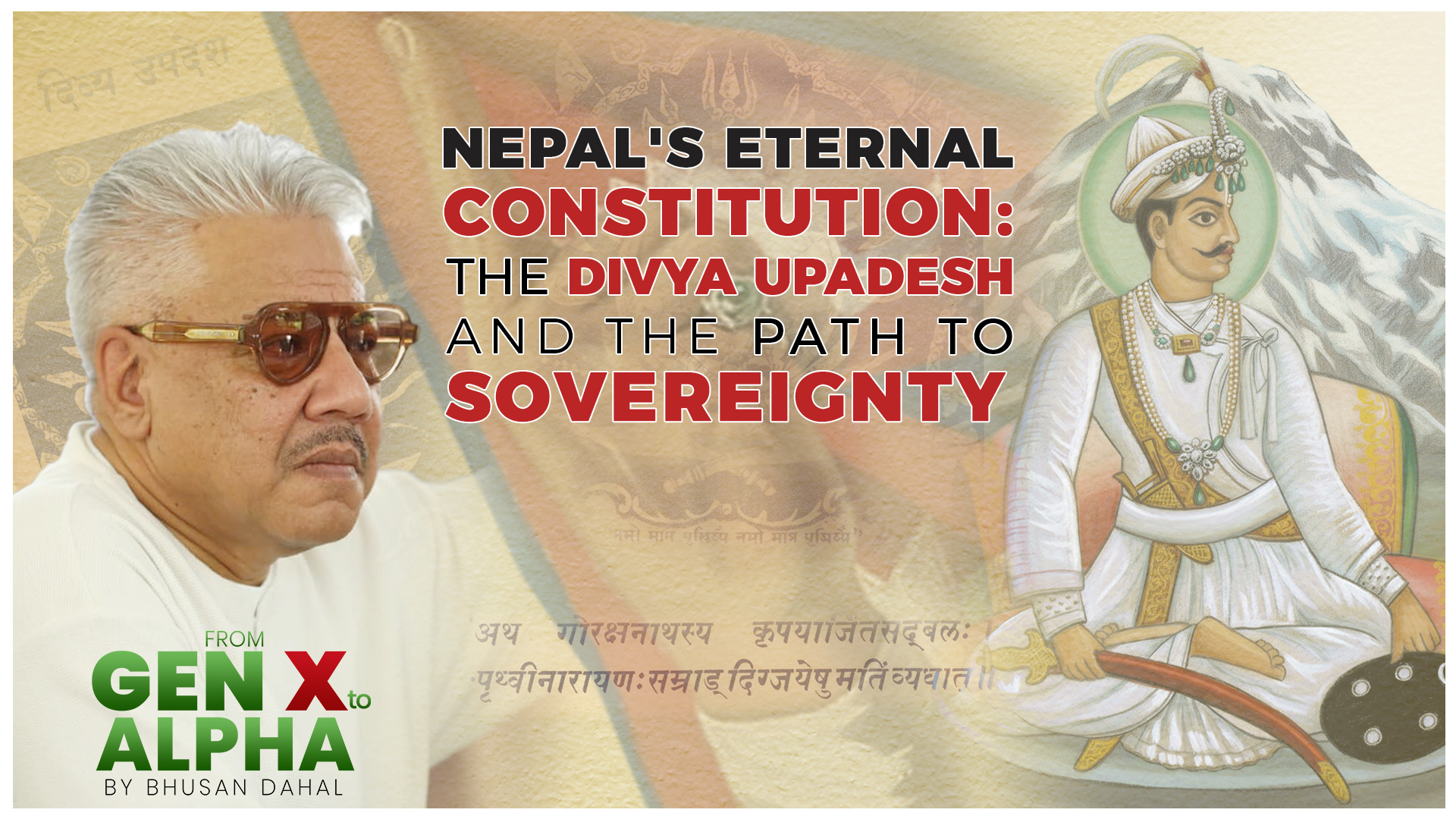Nepal, a nation forged through the vision and valor of King Prithvi Narayan Shah the Great, has stood as a unified entity for centuries, predating even the formation of the United States. At the heart of this unification lies a timeless guiding framework—the Divya Upadesh (Divine Counsel), a set of principles laid down by the founder of modern Nepal. This article argues that the Divya Upadesh is Nepal’s eternal constitution, a sacred blueprint that transcends the need for modern constitutional experiments. Instead of chasing imported ideologies or clinging to the myth of a “living constitution,” Nepal must return to its roots, using bylaws to manage daily governance while preserving its sovereignty in a complex geopolitical landscape.

The Divya Upadesh: Nepal’s Eternal Constitution
Long before the modern concept of written constitutions, King Prithvi Narayan Shah, in the 18th century, provided Nepal with a guiding philosophy that encapsulated the essence of statecraft, unity, and sovereignty. The Divya Upadesh is not merely a historical artifact but a strategic vision that addressed Nepal’s unique geopolitical position, cultural diversity, and existential challenges. It emphasized unity, self-reliance, and vigilance against external influences—principles as relevant today as they were centuries ago. Unlike modern constitutions, which are often amended, debated, or replaced, the Divya Upadesh is eternal because it is rooted in timeless truths about Nepal’s identity and survival. It advised against foreign domination, promoted internal cohesion among diverse communities, and stressed the importance of a strong, centralized leadership to safeguard the nation. King Prithvi Narayan Shah’s counsel was not a rigid legal document but a flexible, principle-based framework that allowed Nepal to adapt while remaining anchored to its core values.

The Fallacy of a “Living Constitution”
In recent decades, Nepal has been caught in a cycle of constitutional experimentation, with multiple constitutions drafted and discarded since the 1950s. The current 2015 Constitution, often hailed as a “living document,” is seen by some as a progressive step toward inclusivity and democracy. However, this belief is a myth that risks eroding Nepal’s sovereignty. The frequent rewriting of constitutions reflects a lack of confidence in Nepal’s indigenous wisdom and an overreliance on imported ideologies that do not fully align with the nation’s unique context. The Divya Upadesh already provides the foundational principles for governance. What Nepal needs are not new constitutions but practical bylaws to address day-to-day administrative and legal matters. Bylaws, grounded in the spirit of the Divya Upadesh, would allow the nation to function efficiently while preserving its cultural and political identity. The obsession with constitutional reinvention distracts from the real task: implementing policies that reflect Nepal’s historical resilience and strategic foresight.

The Geopolitical Imperative
Nepal’s geopolitical position, nestled between two global giants—India and China—has remained largely unchanged since the time of Prithvi Narayan Shah. His Divya Upadesh famously described Nepal as a “yam between two boulders,” urging the nation to maintain neutrality and independence to avoid being crushed by external powers. This advice is as critical today as it was in the 18th century, given the growing influence of foreign actors in Nepal’s politics and economy. The current trend of adopting foreign ideologies—whether liberal democratic frameworks or other imported models—threatens to dilute Nepal’s ability to navigate its delicate geopolitical reality. The Divya Upadesh warns against such vulnerabilities, advocating for self-reliance and strategic diplomacy. By returning to these principles, Nepal can resist external pressures and maintain its sovereignty in an increasingly polarized world.
The Gen Z Revolution: A Call to Return to Root
Nepal’s younger generation, particularly Gen Z, is at a crossroads. Fueled by global connectivity and exposure to international ideas, many are drawn to ideologies that promise progress but may not suit Nepal’s unique context. The energy and idealism of Gen Z are powerful forces for change, but they must be channeled wisely. The Divya Upadesh offers a framework that is neither regressive nor dogmatic but deeply pragmatic, rooted in Nepal’s history and tailored to its future. The revolution Nepal needs is not one that dismantles its identity in pursuit of foreign ideals but one that rediscovers the wisdom of its founder. By embracing the Divya Upadesh as the nation’s eternal constitution, Gen Z can lead the charge in crafting bylaws that address modern challenges such as economic development, environmental sustainability, and social inclusion while preserving Nepal’s sovereignty and cultural heritage.
The Myth of Redemption Through Constitutionalism
The belief that Nepal’s salvation lies in perfecting a modern constitution is dangerous myth. Each new constitution has promised redemption, yet political instability, corruption, and external interference persist. The Divya Upadesh reminds us that true redemption comes from unity, self-reliance, and adherence to principles that have stood the test of time. Clinging to the idea of a “living constitution” risks entangling Nepal in endless debates and divisions, weakening its ability to act decisively in defense of its sovereignty. If Nepal continues down this path, it may find itself too late to reclaim its agency, with too little strength to resist external domination. The Divya Upadesh is a call to action-a reminder that Nepal’s strength lies in its ability to stay true to its roots while adapting to the demands of the modern world.
Conclusion: A Path Forward
Nepal does not need another constitution; it already has one in the Divya Upadesh. What it requires are bylaws that operationalize these timeless principles for the 21st century. By returning to the wisdom of King Prithvi Narayan Shah, Nepal can navigate its geopolitical challenges, harness the energy of its youth, and safeguard its sovereignty. The Divya Upadesh is not a relic of the past but a living guide for the future-one that can lead Nepal toward a path of unity, resilience, and independence. Let the Gen Z revolution be one of rediscovery, not reinvention, as Nepal reclaims its eternal constitution and charts its own destiny.










Great Article
bhimsn29@gmail.com
I have long been writing on the need to return to the roots. The only stabilising factor is the restitution of monarchy in the fluid and unsettling political environment in our country that we have been witnessing eversince the Monarchy was done away with.
What those politucal parties which came to power and ruled under the republic political order have done to the country is there foe everyone to see.
They have thrown to dogs our beautiful country, a peaceful country with eversmiling and industrious people!
It is about time that we throw off these bloodsucking leeches!